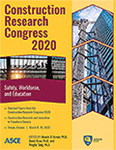Construction Research Congress 2020
Hiring Native American Faculty in Engineering and Construction: Challenges from an Institutional Perspective
Publication: Construction Research Congress 2020: Safety, Workforce, and Education
ABSTRACT
Engineering schools, including construction engineering and management programs, have been generally unable to recruit Native American (NA) faculty in the United States. Consequently, NA construction and engineering students lack role models in academia, and research universities miss the opportunity of producing research that is relevant to NA issues. To understand what are the challenges to hiring NA faculty as perceived by the institutions, the authors interviewed engineering deans from various research institutions across the country. The preliminary results presented in this paper show that university administrators perceive the “lack of NA applicants” as the main challenge to hiring NA faculty in engineering. However, the results also highlighted that most of the institutions that participated in this study do not provide enough resources to support the NA’s desire to give back to their communities. Most deans admitted not being aware of whether their colleges engage with NA tribes in terms of research and service. Also, from the few examples of tribal engagement brought up by the deans, most were limited to temporary research projects that investigated tribal issues. Finally, the vast majority of the deans acknowledged that their colleges avoid hiring their own Ph.D. candidates as faculty, which poses an extra challenge to NA applicants, many of which want to remain close to their families and communities.
Get full access to this article
View all available purchase options and get full access to this chapter.
ACKNOWLEDGEMENTS
This work was supported by the National Science Foundation Broadening Participation in Engineering program, EEC 1542731. Any opinions, findings, conclusions, or recommendations expressed in this paper are those of the authors and do not necessarily reflect the views of the NSF. The authors would also like to thank the University Office of Evaluation and Education Effectiveness (UOEEE) at Arizona State University for the help in coding and analyzing the data.
REFERENCES
Brayboy, B. M. (2005). “Transformational resistance and social justice: American Indians in Ivy League universities.” Anthropology and Education Quarterly, 36(3), 193-211.
College Express. (2019). “4-Year Colleges with the Largest Enrollment of American Indian or Alaska Native Students.” <https://www.collegexpress.com/lists/list/4-year-colleges-with-the-largest-enrollment-of-american-indian-or-alaska-native-students/372/> (July 28, 2019)
Dvorakova, A. (2018). “Contextual identity experiencing facilitates resilience in Native American academics. The Social Science Journal, 55, 346-358.
Fox, M. T. (2005). “Voices from within: Native American faculty and staff on campus.” New Directions for Student Services, 109, 49-59.
Fries-Britt, S. L., Rowan-Kenyon, H. T., Perna, L. W., Milem, J. F., & Howard, D. G. (2011). “Underrepresentation in the academy and the institutional climate for faculty diversity.” The Journal of Professoriate, 5(1), 1-34.
Leggon, C. B. (2010). “Diversifying science and engineering faculties: Intersections of race, ethnicity, and gender.” American Behavioral Scientist, 53(7), 1013-1028.
Lopez, J. D. (2017). “Factors influencing American Indian and Alaska Native postsecondary persistence: AI/AN Millenium Falcon Persistence Model.” Research in Higher Education, 59(6), 792–811.
National Science Foundation. “Data Tables.” Science & Engineering Doctorates: <https://ncses.nsf.gov/pubs/nsf19301/data> (December 4, 2018).
Nelson, D. J., & Brammer, C. N. (2010). “A national analysis of minorities in science and engineering faculties at research universities.” University of Oklahoma.
Snyder, T. D., de Brey, C., & Dillow, S. A. (2019). “Digest of education statistics 2017.” National Center for Research Statistics, U.S. Department of Education,
Tapia, R. (2010, March). “Broadening participation: Hiring and developing minority faculty at research universities.” Communications of the ACM, 53(3).
Towns, M. H. (2010, March/April). “Where are the women of color? Data on African American, Hispanic, and Native American faculty in STEM.” Journal of College Science Teaching, 8-9.
U.S. Census Bureau. (2012). “2010 Census Shows Nearly Half of American Indians and Alaska Natives Report Multiple Races.” Newsroom Archive. <https://www.census.gov/newsroom/releases/archives/2010_census/cb12-cn06.html> (July 28, 2019s).
U.S. Census Bureau. “Annual Estimates of the Resident Population by Sex, Race, and Hispanic Origin for the United States, States, and Counties: April 1, 2010 to July 1, 2018.” 2018 Population Estimates. <https://factfinder.census.gov/faces/tableservices/jsf/pages/productview.xhtml?src=bkmk#>; (July 28, 2019).
U.S. News. (2019). “Best Engineering Schools.” U.S. Rankings: Best Grad Schools. <https://www.usnews.com/best-graduate-schools/top-engineering-schools/eng-rankings> (July 28, 2019).
Villalpando, O., & Bernal, D. (2002). “A Critical Race Theory analysis of barriers that impede the success of faculty of color.” The Racial Crisis in American Higher Education: Continuing Challenges for the Twenty-first Century, P. A. W.A. Smith, eds., State of New York Press, Albany, NY, 243-269.
Windchief, S., & Brown, B. (2017). “Conceptualizing a mentoring program for American Indian/Alaska Native students in STEM fields: A review of the literature.” Mentoring & Tutoring: Partnership in Learning, 25(3), 329-345.
Yoder, B. L. (2017). “Engineering by the Numbers.” American Society of Engineering Education.
Information & Authors
Information
Published In
Construction Research Congress 2020: Safety, Workforce, and Education
Pages: 773 - 781
Editors: Mounir El Asmar, Ph.D., Arizona State University, David Grau, Ph.D., Arizona State University, and Pingbo Tang, Ph.D., Arizona State University
ISBN (Online): 978-0-7844-8287-2
Copyright
© 2020 American Society of Civil Engineers.
History
Published online: Nov 9, 2020
Published in print: Nov 9, 2020
Authors
Metrics & Citations
Metrics
Citations
Download citation
If you have the appropriate software installed, you can download article citation data to the citation manager of your choice. Simply select your manager software from the list below and click Download.
